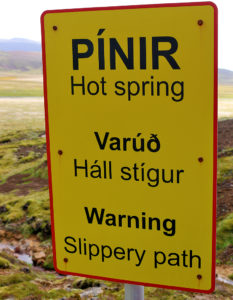
Still on my first day in Iceland after having arrived from the United States earlier that morning and visited such sites as the bridge between the North American and Eurasian continental plates at Miðlína, the Brimketill lava rock pool, the ruins at the oldest lighthouse in Iceland known as Reykjanesviti, I ventured on to Krýsuvík geothermal area.
Krýsuvík Geothermal Area in Iceland
Although a number of places around the world have such features as hot springs or mud pools, the four largest — and best known — geothermal areas in the world are in the United States, New Zealand, Iceland and Russia. I have now been to three of them.

Steam rises from the hot mud pools into the crisp Icelandic air.

You can visit several geothermal areas in Iceland — including Hverarond Namaskard, which I also visited and will document in a different article; and Krýsuvík, which includes its remarkable solfatara fields.

At Krýsuvík, you will find an expanse of steaming volcanic vents, fumaroles,, boiling hot springs, bubbling mud pots, and cold water springs.

The hot mud constantly boils with bubbles.

Yes, the rhythmic bubbles sound like boiling water — because in many cases, it is boiling water.

I watched the water from the hot springs meander as it flowed over rocks, creating a miniature canyon of sorts.

This is a closer view of that hot spring, which left deposits on the rocks that accumulated over the years.

Seltún is one of the geothermal fields of Krýsuvík.

While some areas of Krýsuvík seem to be in turmoil, others offer relaxingly picturesque views.

Streams of cold water from springs trickle down slopes and through rocks.

This is a closer view of one of those streams of cold water — complete with miniature waterfalls…

…and here is an even closer view towards the bottom of those miniature waterfalls.

Visitors notice that the wooden boardwalk — which is well maintained — winds its way from the parking lot through the range of multi-colored hills which tend to frame the geothermal areas of Krýsuvík dramatically.

Prepare to be overwhelmed by the pungent smell of the sulphur deposits, which resembles the odor of rotten eggs or sewage.

1

2

Krýsuvík is situated at the middle of the fissure zone on the Mid-Atlantic Ridge which traverses Iceland.

Photographs do not do justice to the colors found at Krýsuvík.

Steam rises from the bubbling hot muddy water.

No matter which geothermal area you visit, do not venture off of the designated paths, as the boiling and steaming geothermal vents are dangerous. Do not walk on them or attempt to touch them — rather, always stay on the designated path.

Look carefully and you can see this mud pool bubbling and churning.

3

4

The boardwalk winds its way through the bubbling and hissing geothermal area of Krýsuvík, with informative signs which explained all the important geological facts of the area.

Columns of steam rise from vents in the land as well as from the water from the hot springs.

The stream flows from the other hot springs past this one — which is one of the largest of the hot springs in Krýsuvík — before it leaves the geothermal area.

The magnificent nature of the Krýsuvík area is very delicate; and treating it with great care and respect is required to ensure that future generations can visit to appreciate it.

Parts of Krýsuvík remind me of the southwestern United States, with its colorful hills and rugged terrain.

Summary
For a detailed map of the Krýsuvík area — which is located on the Reykjanes peninsula in Iceland — you may contact the Hafnarfjörður Tourist Information Centre. You can also find out information about hiking and walking routes — as well as information pertaining to local history, geology, folklore and attractions.
Although parts of the geothermal area of Krýsuvík are unique, your visit may not be as exciting if you have already been to Yellowstone National Park in the United States, as there are no geysers — nor are there nearly as many thermal features — but I would not miss visiting Krýsuvík anyway if you have the time.
No bus service to Krýsuvík exists; so a car to travel there is required — and some of the road is unpaved.
There are no facilities and no admission fee to enjoy the geothermal area of Krýsuvík — which is located off of highway 42 near Hafnarfjörður, which is located approximately 18 kilometers from the city center of Reykjavík — where you can stay as long as you like, as it is technically open 24 hours per day, 365 days per year.
All photographs ©2018 by Brian Cohen.

